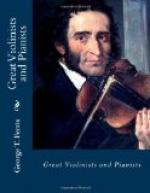out the slightest gradations of tone from the fullest
forte to the softest
piano, to mark
all kinds of strong and gentle accents, to execute
staccato, legato, saltato, and arpeggio passages with
the greatest ease and certainty. The French school
of violin-playing did not at first avail itself of
these advantages, and even Viotti and Spohr did not
fully grasp the new resources of execution. It
was left for Paganini to open a new era in the art.
His daring and subtile genius perceived and seized
the wonderful resources of the modern bow at one bound.
He used freely every imaginable movement of the bow,
and developed the movement of the wrist to that high
perfection which enabled him to practice all kinds
of bowing with celerity. Without the Tourte bow,
Paganini and the modern school of virtuosos, which
has followed so splendidly from his example, would
have been impossible. To many of our readers an
amplification of this topic may be of interest.
While the left hand of the violin-player fixes the
tone, and thereby does that which for the pianist is
already done by the mechanism of the instrument, and
while the correctness of his intonation depends on
the proficiency of the left hand, it is the action
of the right hand, the bowing, which, analogous to
the pianist’s touch, makes the sound spring
into life. It is through the medium of the bow
that the player embodies his ideas and feelings.
It is therefore evident that herein rests one of the
most important and difficult elements of the art of
violin-playing, and that the excellence of a player,
or even of a whole school of playing, depends to a
great extent on its method of bowing. It would
have been even better for the art of violin-playing
as practiced to-day that the perfect instruments of
Stradiuarius and Guarnerius should not have been, than
that the Tourte bow should have been uninvented.
The long, effective sweep of the bow was one of the
characteristics of Viotti’s playing, and was
alike the admiration and despair of his rivals.
His compositions for the violin are classics, and Spohr
was wont to say that there could be no better test
of a fine player than his execution of one of the
Viotti sonatas or concertos. Spohr regretted
deeply that he could not finish his violin training
under this great master, and was wont to speak of
him in terms of the greatest admiration. Viotti
had but few pupils, but among them were a number of
highly gifted artists. Rode, Robrechts, Cartier,
Mdlle. Gerbini, Alday, La-barre, Pixis, Mari,
Mme. Paravicini, and Vacher are well-known names
to all those interested in the literature of the violin.
The influence of Viotti on violin music was a very
deep one, not only in virtue of his compositions,
but in the fact that he molded the style not only of
many of the best violinists of his own day, but of
those that came after him.
LUDWIG SPOHR.




